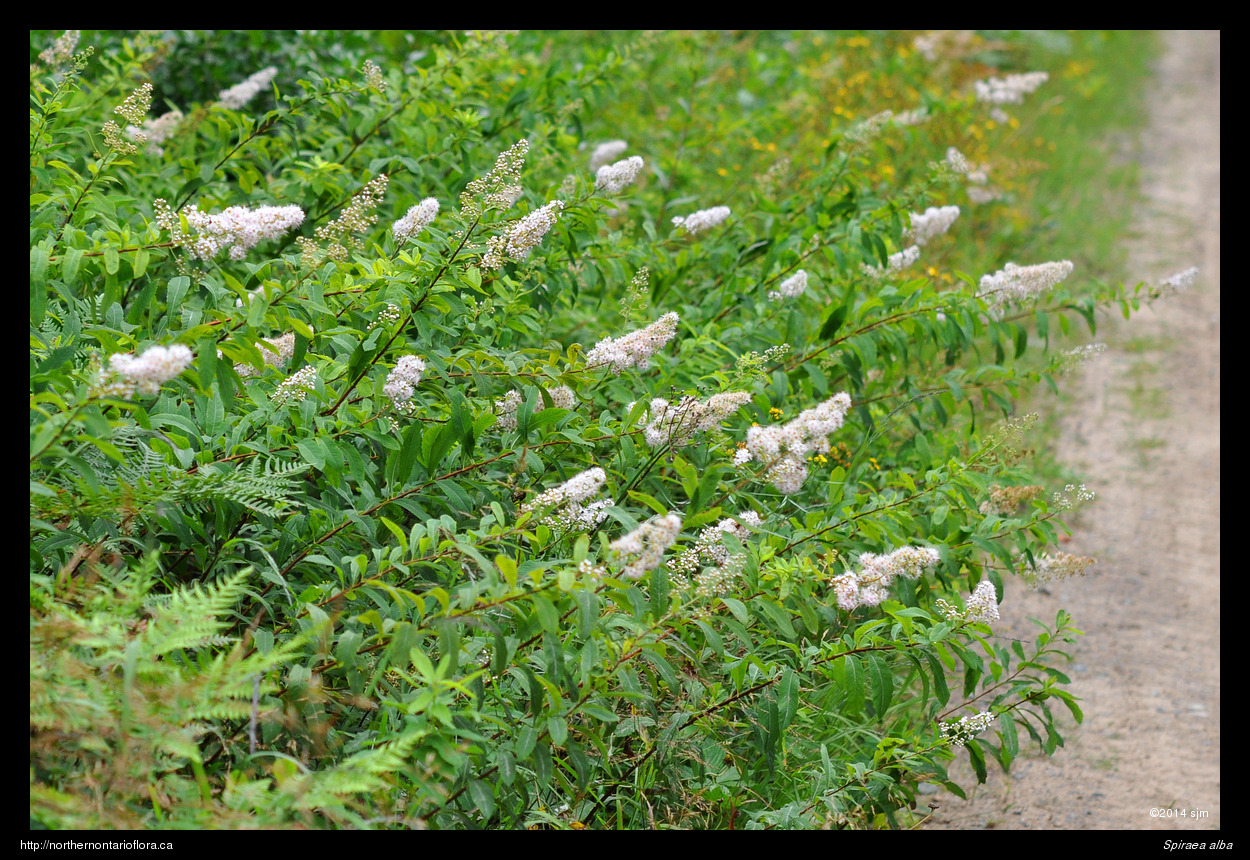
|
Northern Ontario Plant Database 
Plant DescriptionSpiraea alba DuRoiEn: white meadowsweet, narrowleaf meadowsweet
Rosaceae (Rose Family) General: An erect deciduous shrub, 0.3-1.2 m tall; with a narrow-pyramidal inflorescence and branches bearing numerous overlapping leaves. Stems/twigs: Twigs are smooth (glabrous), yellowish-brown to reddish-brown, and marked with longitudinal ridges, making them appear somewhat angled. Older stems have thin papery bark that is somewhat shreddy. Buds are alternate, small, reddish-brown, scaly, and finely hairy near the tip. Leaves: Alternate, simple, pinnately-veined, and with a short petiole, 2—6 mm long. Leaf blades are narrowly-elliptic to oblanceolate, glabrous on both surfaces, 3—7 cm long by 1—2 cm wide, and 3—4 times as long as wide. Leaf blades taper gradually to the base (cuneate) and the apex is pointed (acute); leaf margins are sharply toothed (serrate) from below the middle, but entire near the base. Flowers: Bisexual, with many small flowers borne in terminal branched inflorescences (panicles), to 15 cm long. Panicles are narrow and elongate, with finely pubescent branches and flower stalks (pedicels). Individual flowers are 6—8 mm across, have a shallow cup-shaped hypanthium with 5 reflexed calyx lobes, 5 rounded pinkish to white petals, and numerous stamens on long exserted filaments, which are attached to the rim of the pink- to red-edged hypanthium; within the hypanthium are 5—8 pistils with superior ovaries. Flowers bloom in mid-summer. Fruit: Each pistil of the flower develops into a small dry fruit (follicle), which changes from green to reddish-yellow, then brown at maturity; each follicle contains a few tiny seeds. Fruits mature in early fall; fruiting inflorescences persist over winter. Habitat and Range: Shorelines, marshes, wet meadows, ditches, and low, wet ground. White meadowsweet is native to north-temperate and boreal North America, extending from southwestern Quebec to Alberta. Locally, its range extends throughout the Algoma District and across Ontario, extending north to about the middle of the James Bay coast. Similar Species: The broadleaf meadowsweet (Spiraea latifolia (Aiton) Borkh.) has larger wider leaves, 1.5—4 cm wide, that are oval to broadly oblanceolate, with blunt to rounded apices; leaves are 2—3 times as long as broad. Panicles are broader, and branches of the inflorescence and pedicels are glabrous. Broadleaf meadowsweet is present in our area, but much less common and does not range as far north as white meadowsweet. Steeplebush or hardhack (Spiraea tomentosa L.) is occasionally present but uncommon in southern Algoma. it can be recognized by its panicles of deep pink flowers and blunt leaves with a dense wooly lower surface of tawny-brown hairs. Steeplebush grows in habitats similar to white meadowsweet, but commercial cultivars are sold for gardens and may occasionally escape. Back to species list |
||||||||||||||||||||||






















